Wednesday Sept. 27, 2006
New Optional Assignment due next Monday (at the beginning of class)
We'll finish the section on the Causes of the Seasons today. It's
not too early to study this material; have a look at the start of the Quiz #2 Study Guide.
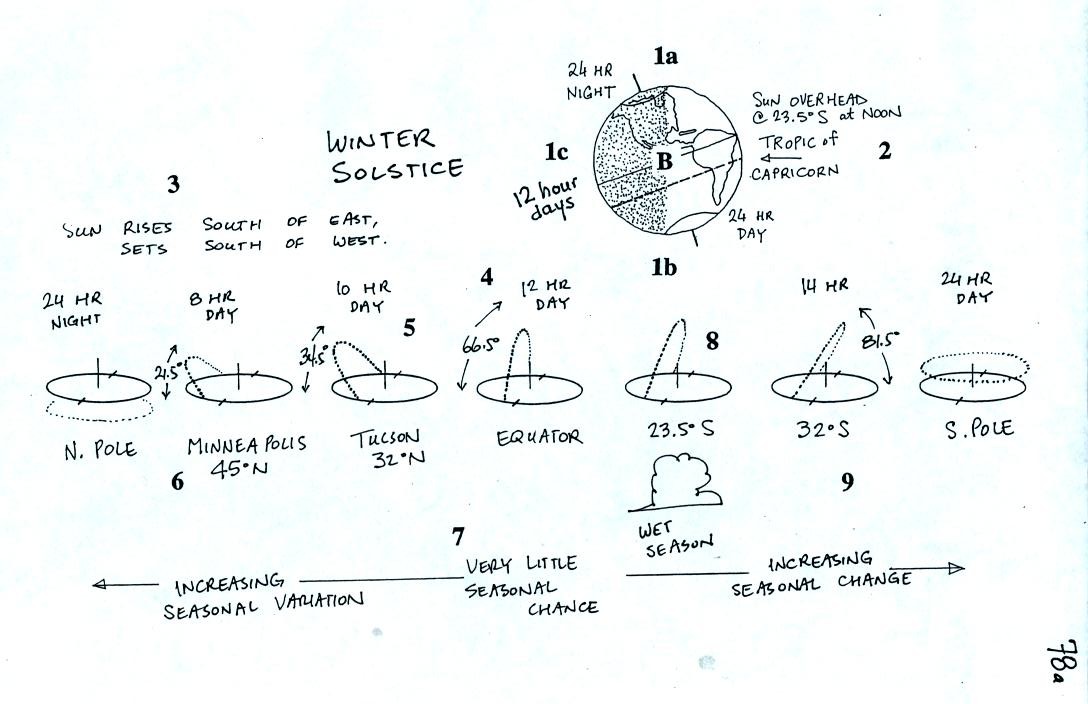
We went through some of the numbered points on the winter
solstice diagram on p. 78a in the photocopied class notes. The
numbered points are discussed in detail on p. 78b in the class notes.
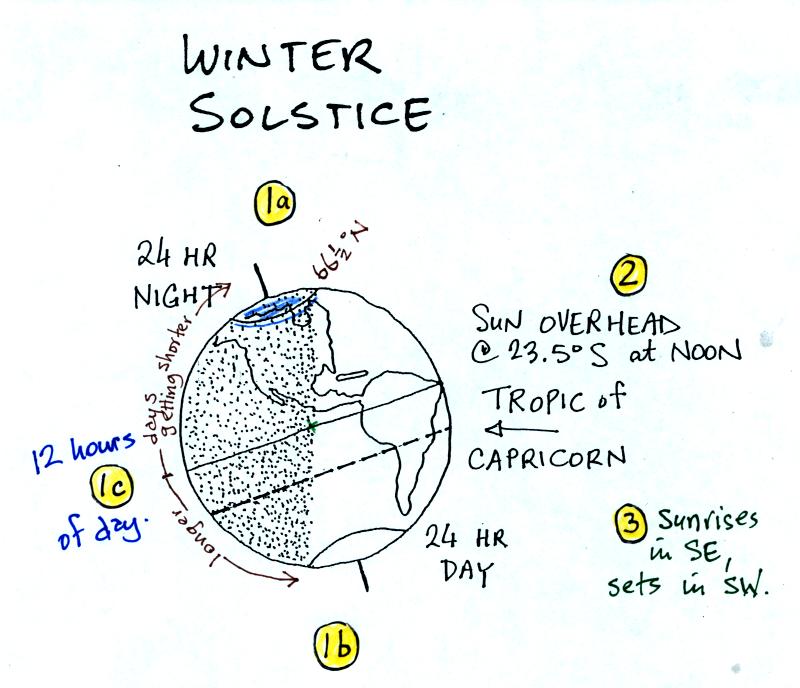
1a
There are 0 hours of daylight north of the Arctic circle.
1b
There are 24 hours of day south of the Antarctic circle
1c
Halfway in between you would find 12 hours days at the equator.
Days are always 12 hours long at the equator.
As you move from the equator toward the north pole the days get
shorter. The days get longer as you move from the equator toward
the south pole.
2 The
sun is now overhead at 23.5o S latitude, the Tropic of Capricorn, at
noon
3 On
the winter solstice the sun rises in the SE and sets in the SW.

On Dec. 21 at the equator, the sun doesn't pass
overhead. The sun
is still high in the sky at noon, however. At the equator the sun
is never lower than 66.5 degrees at noon. That coupled with the
fact that
the days are 12 hours long year round you can understand why seasonal
changes are minimal at the equator.

5.
In
Tucson on Dec. 21, the sun only gets 34.5 degrees above the southern
horizon at noon. The days are only 10 hours long. Quite a
bit less energy arrives at the ground during the winter than at other
times of the year. That's is why it is the winter season.
6. Even less energy
reaches the ground in Minneapolis because the days are 2 hours shorter
and the sun is signficantly lower in the sky at noon.
7. Remember the
very small seasonal changes at the equator. As you move away from
the equator toward higher latitude the seasonal changes become larger
and larger. We'll see how small of a seasonal change there can be
in class on Thursday.
Now a quick look at a place where there is essentially no seasonal
change during the year. Pohnpei, in the Federated States of
Micronesia is located at 7o N latitude in the middle of the Pacific
Ocean. Commercial airlines fly to Pohnpei on the way to and from
Guam (you'll find the map below on p. 81 in the photocopied class
notes). Your course instructor had the opportunity to visit
Pohnpei while enroute to Kapingamarangi Atoll as part of a large
meterological field experiment.
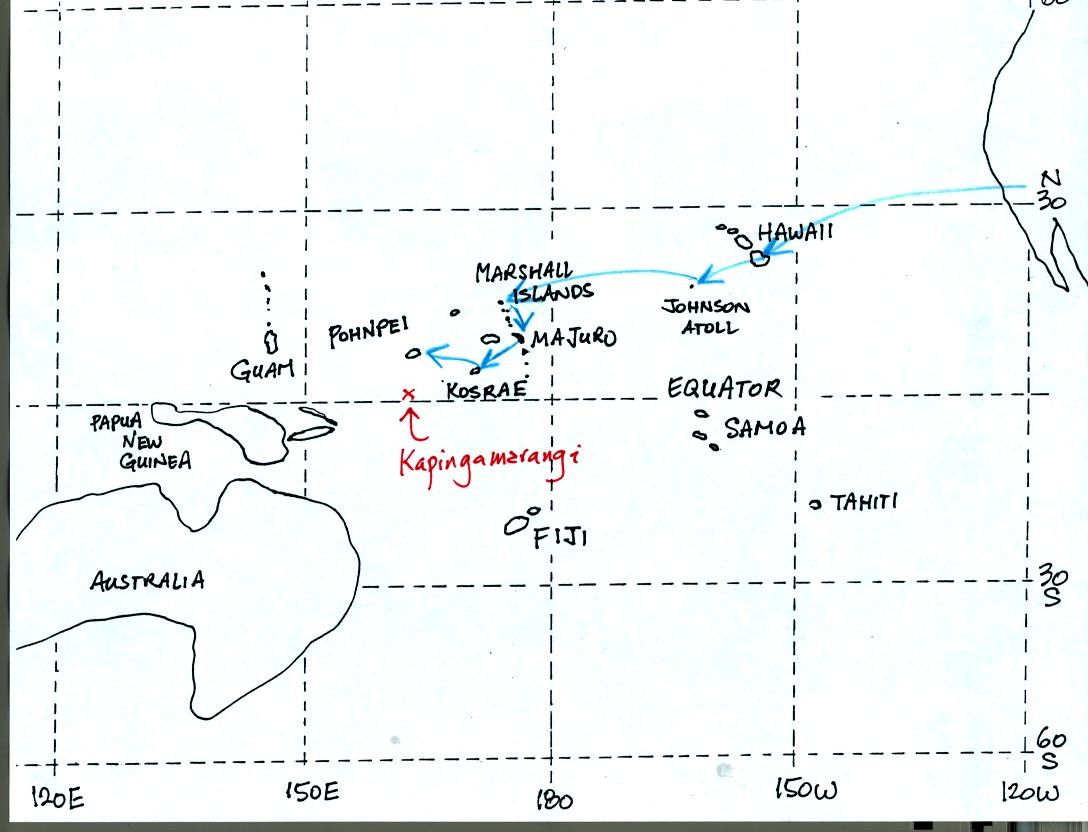
The next figure gives a little information about the island
of Pohnpei. Pohnpei and some of the nearby islands are popular
tourist destinations because of world class snorkeling and scuba diving.

There is a weather station at Kolonia, the largest city on Pohnpei
island operated by NOAA (the US National Atmospheric and Oceanic
Administration). The next figure shows the monthly average
temperatures for the city of Kolonia.
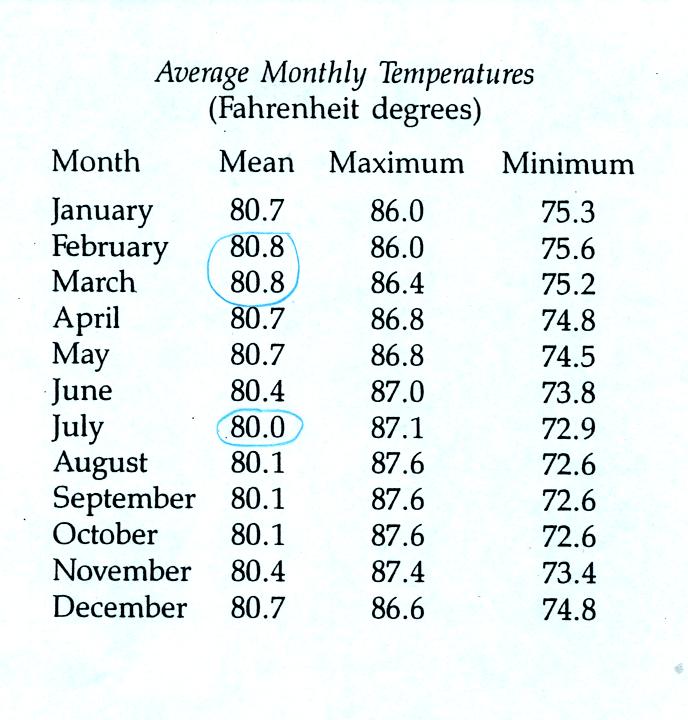
There is less than 1 F difference between the warmest and coldest
months in Kolonia. By contrast, in Tucson July has an average
temperature of 86 F while January and December have monthly average
temperatures of 52 F. There is no winter or summer on
Pohnpei. The interior of Pohnpei receives around 400 inches of
rain in a year, making it one of the rainiest locations on earth.
Pohnpei has such a small annual range of temperature because of its low
latitude and because it is surrounded by ocean.
Next we
had a quick look at the summer solstice.

Each of the numbered points is discussed on p. 80 in the photocopied
class notes.
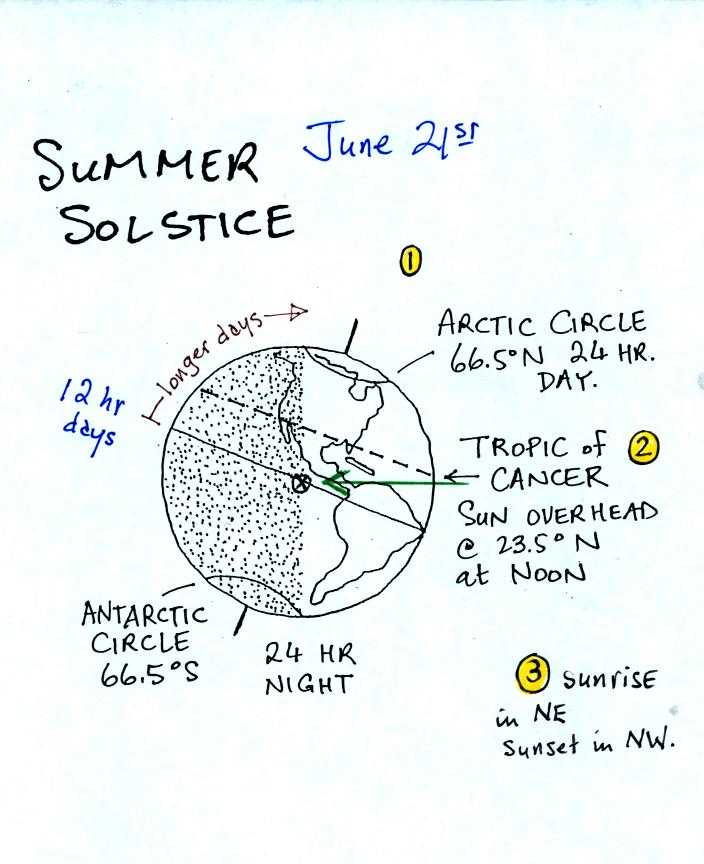
You should be getting pretty good at this by now.
1. There is 24 hours of daylight above the
Arctic Circle on June 21, the summer solstice. South of the
Antarctic circle 0 hours of daylight. At the equator, halfway in
between, the days are 12 hours long. Days get longer with
increasing latitude in the northern hemisphere and get shorter with
increasing latitude in the southern hemisphere.
2. The sun will pass straight overhead at noon
at 23.5 north latitude, the Tropic of Cancer.
3. The sun will rise in the NE and set in the
NW on the summer solstice (you'll see this again a few figures down in
today's notes)
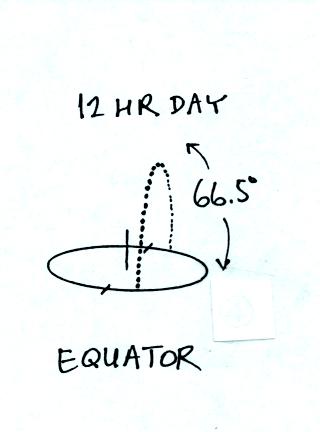
This figure wasn't shown in class. It just shows you again that
the sun is always high in the sky at the equator at noon. It was
66.5 degrees above the southern horizon on the winter solstice, now it
is 66.5 degrees above the northern horizon.

5. As you move from the equator toward higher
latitude in the northern hemisphere the days get longer. The days
are 12 hours long at the equator, 14 hours long in Tucson, 16 hours
long in Minneapolis and 24 hours long north of the Arctic circle.
6. In Tucson the sun rises in the NE around
5:30 am or so. It then moves over into the southern sky and is
81.5 degrees above the southern horizon at noon. It is not
directly overhead but it is close. The sun sets in the NW around
7:30 pm. The long days and the intense sunlight arriving at the
ground when the sun is high in the sky means there will be much more
energy making it to the ground this time of the year. The ground
gets hotter; this is summer.
7. Now you might think that Minneapolis would
get even more sunlight energy during the day because the days are 16
hours long there. Note however that the sun is lower in the sky
at noon. The two factors (length of day, angle of the sun in the
sky) that determine how much energy arrives at the ground are working
against each other.
That means that somewhere between 23.5 degrees and the north pole there
will be an optimum combination of length of day and angle of the sun in
the sky. This optimal combination will mean the maximum amount of
sunlight energy makes it to the ground. The optimal combination
occurs near 30 degrees latitude. THis is where the world's hot
deserts are found.
You need
to be very carefully crossing east-west oriented streets at sunrise and
sunset. This is because the sun will be shining right in the
driver's eyes and there is a good chance they might not see you.
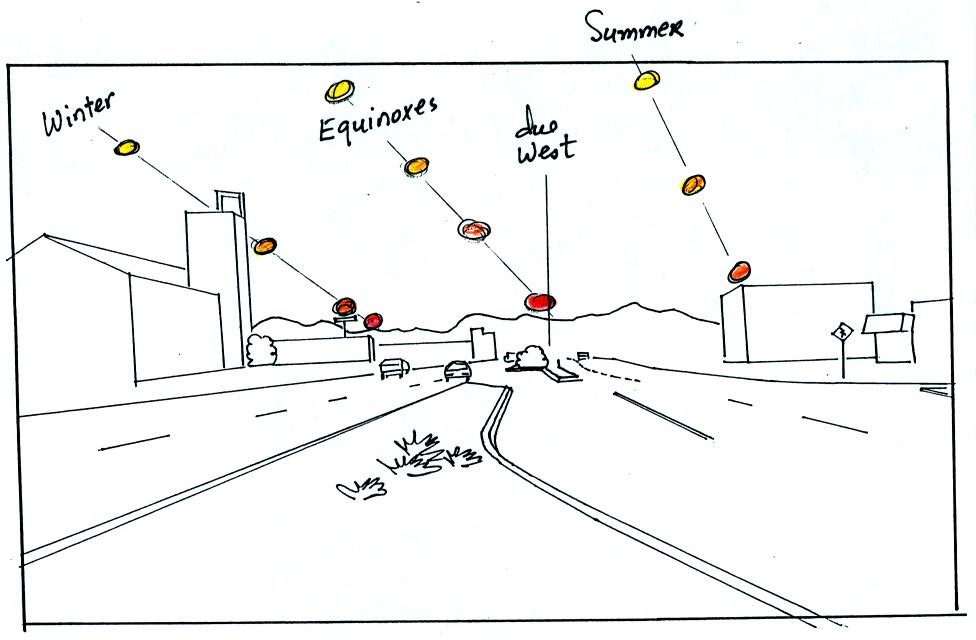
Here's a sketch of what you would see looking west along Speedway
Blvd. On the equinoxes you will see the sun exactly in
the west
(a multiple exposure photograph was shown in class). If you are
driving west at this time the sun will be in your eyes and will make it
hard to see in front of you. In the winter the sun sets in the
southwest (further west than shown here). In the summer the sun
sets in the NW (further NW than shown here).

An actual newspaper report on or near the fall equinox.
In the
last few minutes of class we covered the following introduction to the
material at the beginning of Chapter 2. We do this because it is
easy to lose sight of our overall objective because of all the little
details we will run into in Chapter 2.
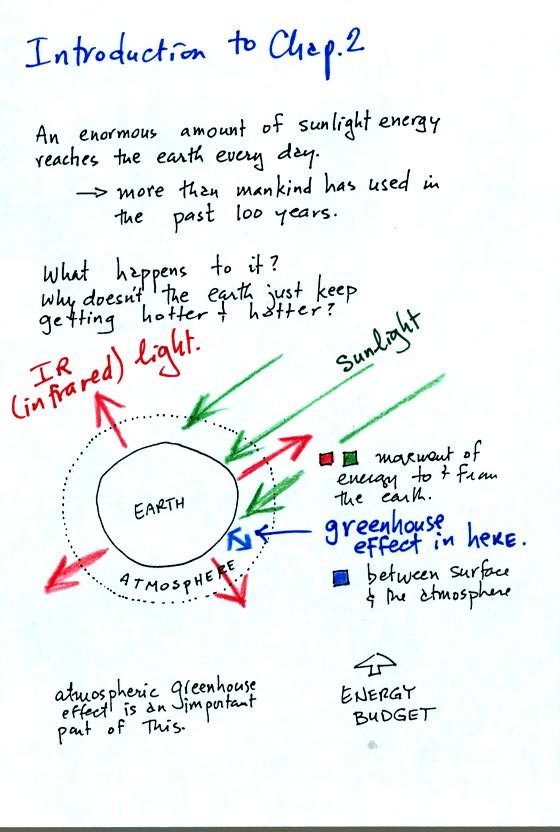
An enormous amount of sunlight energy reaches the earth
everyday.
We will learn how it is possible for this form of energy to travel
through empty space. We know about this sunlight energy because
we can see it (at some of it) and can feel it (you get warm when you
stand in the sunlight). With all of this energy arriving at and
being
absorbed by the earth, what keeps the earth from getting hotter and
hotter? The answer is that the earth also sends energy back into
space. This infrared light is an invisible form of energy; we
don't usually feet it either). A balance
between incoming and outgoing energy is achieved and the earth's annual
average temperature remains constant.
We will also look closely at energy transport between the earth's
surface and the atmosphere. That is where the atmospheric
greenhouse operates. That will be a major goal in Chapter 2 - to
understand the atmospheric greenhouse effect.

Water vapor is a particularly important form of invisible
energy.
When water vapor condenses to produce the water droplets in a
cloud, an enormous amount of energy is released into the atmosphere.
It is hard to visualize or appreciate energy released into the
atmosphere during condensation. You can imagine the work that you
would do carrying a gallon of water
(8 pounds) from Tucson to the top of Mt. Lemmon, however. To
accomplish
the same thing Mother Nature must first evaporate the water and (if my
calculations are correct) that requires about 100 times the energy that
you would use to carry the 8 pounds of water to the summit of Mt.
Lemmon. And Mother Nature transports a lot more than just a
single gallon.

Kinetic energy is energy of motion. Latent heat energy
is an unappreciated form of energy.
The four energy transport
processes are listed at the bottom of the page above. By far the
most important process is electromagnetic radiation. This is the
only process that can transport energy through empty space.
Electromagnetic radiation is also responsible for about 80% of the
energy transport between the ground and atmosphere. You might be
surprised to learn that latent heat is the second most important
transport process.

One of the main objectives in Chapter 2 to understand the
greenhouse
effect.
















